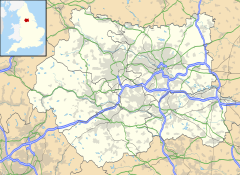Burley, Leeds
| Burley | |
|---|---|
 Looking east over Burley Model Allotments towards Leeds University. |
|
| Burley shown within West Yorkshire | |
| OS grid reference | SE279351 |
| • London | 170 mi (270 km) SSE |
| Metropolitan borough | |
| Metropolitan county | |
| Region | |
| Country | England |
| Sovereign state | United Kingdom |
| Post town | LEEDS |
| Postcode district | LS3, LS4, LS6 |
| Dialling code | 0113 |
| Police | West Yorkshire |
| Fire | West Yorkshire |
| Ambulance | Yorkshire |
| EU Parliament | Yorkshire and the Humber |
| UK Parliament | |
Burley is an inner city area of northwest Leeds, West Yorkshire, England. Burley is situated just over 1 mile (1.6 km) north-west from Leeds city centre, and between the A65 Kirkstall Road at the south, and Headingley at the north. Burley falls within the Kirkstall ward of the City of Leeds.
The place-name 'Burley' is first attested in 1195 as "Burteg" and, around 1200, as "Burcheleia" which is more representative of other medieval attestations. The name derives from Old English burh, a 'fortification' and lēah an 'open space'.
Burley grew from a village in the late industrial revolution. Parts of the original village can still be seen at the junction of Burley Road and Haddon Road, and around Burley Lodge. Most houses constructed in Burley were of red-brick, but were generally smaller and largely back-to-backs. Industrial and commercial buildings were also largely brick-built. There are some larger stone-built buildings on Kirkstall Road such as the ornate Cardigan Arms public house—although this largely pre-dates most of the buildings in the area—which at the time of its construction only Burley Village existed, with the Arms somewhat outside.
Mills along the River Aire were built towards the end of the 19th century, some of which remain standing. Housing for mill workers and others in surrounding areas followed, and homes were built further up the bank. Other industries in the area included printing, clock-making, dairies and chemicals.
The area remained working class for many decades but the growth of the University of Leeds and Leeds Metropolitan University in the late 20th century brought a growing student population to Burley and the surrounding areas of Hyde Park, and Headingley. In the mid- to late 2000s student halls were built along the lower parts of Burley Road.
The railway came to Burley with the opening of the Harrogate Line in 1848. Burley however did not get a station until 1988; until then the nearest was Headingley railway station.
...
Wikipedia

